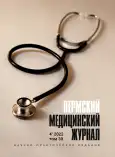Complex wound process in cardiac surgery. Tactics of anterior chest wall reconstruction
- Authors: Kasatov A.V.1,2, Minasyan V.N.1,2,3, Arutyunyan V.B.3, Vronsky A.S.2,3
-
Affiliations:
- Perm Regional Clinical Hospital
- E.A. Vagner Perm State Medical University
- S.G. Suhanov Federal Center of Cardiovascular Surgery
- Issue: Vol 39, No 4 (2022)
- Pages: 71-84
- Section: Methods of diagnosis and technologies
- URL: https://journals.rcsi.science/PMJ/article/view/110802
- DOI: https://doi.org/10.17816/pmj39471-84
- ID: 110802
Cite item
Full Text
Abstract
Objective. The postoperative wound complications are an integral part of the treatment process in any surgical practice. The aim of this work is to optimize the tactics of management and the choice of a method for reconstructing the anterior chest wall of cardiosurgical patients with postoperative sternomediastinitis.
Materials and methods. The development of sternomediastinitis in patients undergoing open heart surgery is the highest risk factor for life. According to many authors, it occurs in 0.5–11 % of patients, while the fatality of this complication can reach up to 40–50 %. This condition develops in a number of patients in a cardiac surgery hospital who have certain developmental predictors.
Results. Thus, in our work, we consider preoperative, intraoperative and postoperative risk factors for the development of sternomediastinitis. Based on all the data studied in the world literature and our own experience, we algorithmized the approach to choosing the tactics of anterior chest wall reconstruction, determined the time frame and gave specific recommendations based on clinical examples, which confirms the practical effectiveness of the proposed methods.
Conclusions. A differentiated approach to the choice of the method of plastic intervention is given, the tactical priority of using muscle flaps or segmental resection of the sternum is substantiated, and the importance of omentoplasty of a chest defect in severe purulent-septic lesions of a large scale is also updated.
Full Text
##article.viewOnOriginalSite##About the authors
A. V. Kasatov
Perm Regional Clinical Hospital; E.A. Vagner Perm State Medical University
Email: mdminasyan@mail.ru
Candidate of Medical Sciences, Head of Department of Hospital Surgery
Russian Federation, Perm; PermV. N. Minasyan
Perm Regional Clinical Hospital; E.A. Vagner Perm State Medical University; S.G. Suhanov Federal Center of Cardiovascular Surgery
Author for correspondence.
Email: mdminasyan@mail.ru
cardiovascular surgeon of Cardiac Surgery Unit №1, Assistant of Department of Hospital Surgery
Russian Federation, Perm; Perm; PermV. B. Arutyunyan
S.G. Suhanov Federal Center of Cardiovascular Surgery
Email: mdminasyan@mail.ru
MD, PhD, cardiovascular surgeon, Head of Cardiac Surgery Unit №1
Russian Federation, PermA. S. Vronsky
E.A. Vagner Perm State Medical University; S.G. Suhanov Federal Center of Cardiovascular Surgery
Email: mdminasyan@mail.ru
cardiovascular surgeon of Cardiac Surgery Unit № 2
Russian Federation, Perm; PermReferences
- Vishnevskij A.A., Rudakov S.S., Milanov O.N. Hirurgiya grudnoj stenki. Moscow: VIDAR 2005; 301 (in Russian).
- Kasatov A.V., Minasyan V.N., Arutyunyan V.B., Vronskij A.S. Dvuhetapnaya taktika lecheniya posleoperacionnogo sternomediastinita metodom otricatel'nogo davleniya s posleduyushchej dvuhloskutnoj omentoplastikoj po K. Yoshida. Permskij medicinskij zhurnal 2021; 6: 127–136 (in Russian).
- Heilmann C., Stahl R., Schneider C., Sukhodolya T. et al. Wound complications after median sternotomy: a single-centre study. Interactive CardioVascular and Thoracic Surgery 2013; 16: 643–648.
- Thorsteinsson D.T., Valsson F., Geirsson A., Gudbjartsson T. Major cardiac rupture following surgical treatment for deep sternal wound infection. Interact Cardio-Vasc Thorac Surg. 2013; 16 (5): 708–709.
- Morgante A., Romeo F. Deep sternal wound infections: a severe complication after cardiac surgery. Il Giornale di chirurgia 2017; 38 (1): 33–36.
- Rogers S.O., Zinner M.J. The role of perioperative hyperglycemia in postoperative infections. Adv Surg. 2009; 43: 103–109.
- Cayci C., Russo M., Cheema F.H. et al. Risk analysis of deep sternal wound infections and their impact on long-term survival: a propensity analysis. Ann Plast Surg. 2008; 61: 294–301.
- Šimek M., Hájek R., Kaláb M., Klváček A., Zálešák B. Strategies preventing deep sternal wound infection in cardiac surgery review. Rozhl Chir. Summer. 2018; 97 (9): 414–418.
- Kawada T. Risk of Sternal Wound Infection by Open Heart Operations Stratified by the Type of Operation. Ann Thorac Surg. 2016; 102 (6): 2137–2138.
- Osawa H., Yoshii S., Abraham S.J., Okamoto Y., Hosaka S., Fukuda S., Tsuchiya K., Nakajima M., Honda Y., Takizawa K. Topical spraying of cefazolin and gentamicin reduces deep sternal wound infections after heart surgery: a multicenter, large volume, retrospective study. Gen Thorac Cardiovasc Surg. 2016; 64 (4): 197–202.
- Sandy-Hodgetts K., Carville K., Leslie G.D. Determining risk factors for surgical wound dehiscence: a literature review. Int Wound J. 2015; 12 (3): 265–275.
- Kohan E.P., Asanov O.N., Potapov V.A. Optimizaciya diagnostiki, lecheniya i profilaktiki infekcionnyh oslozhnenij sternotomnoj rany u kardiohirurgicheskih bol'nyh. Rany i ranevye infekcii: materialy III Mezhdunarodnogo kongressa. Moscow 2016; 172–174 (in Russian).
Supplementary files








